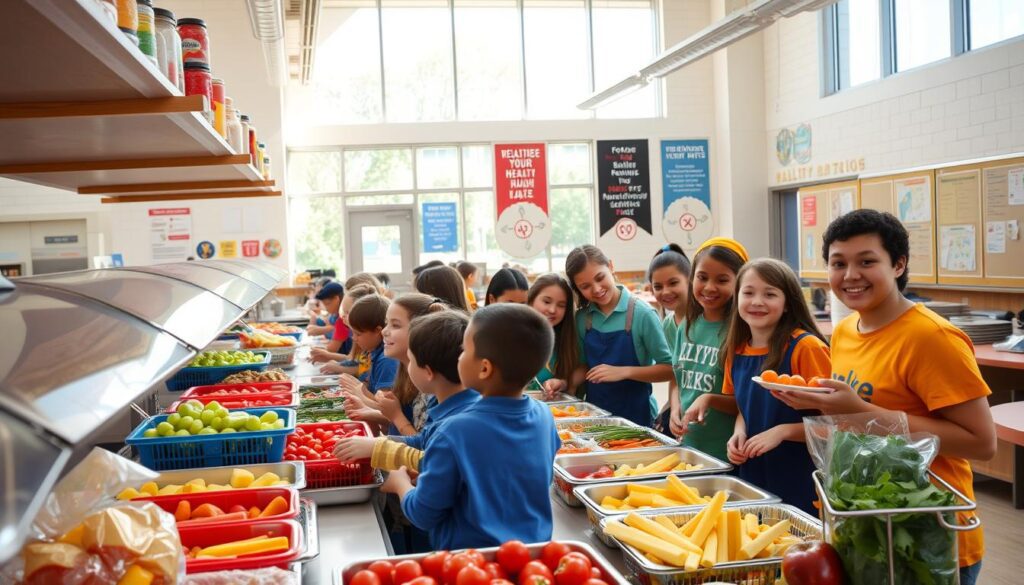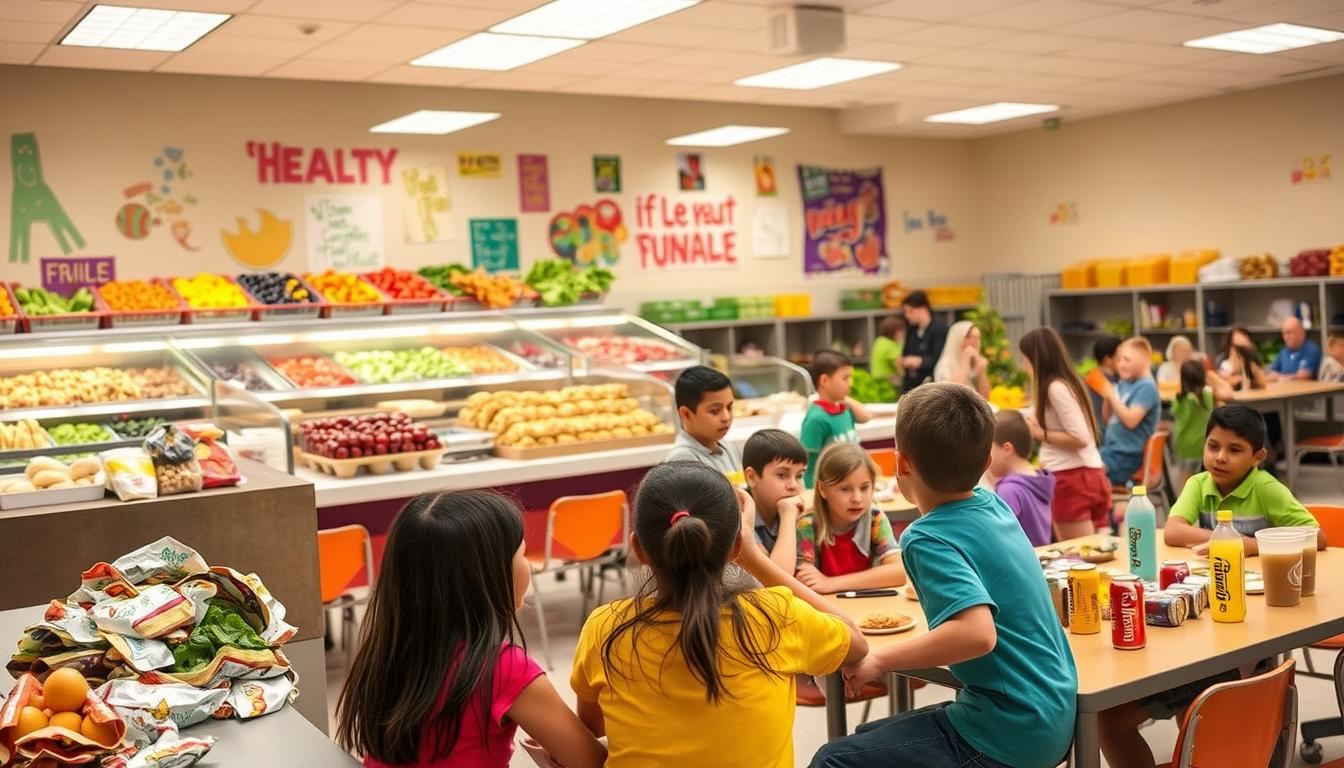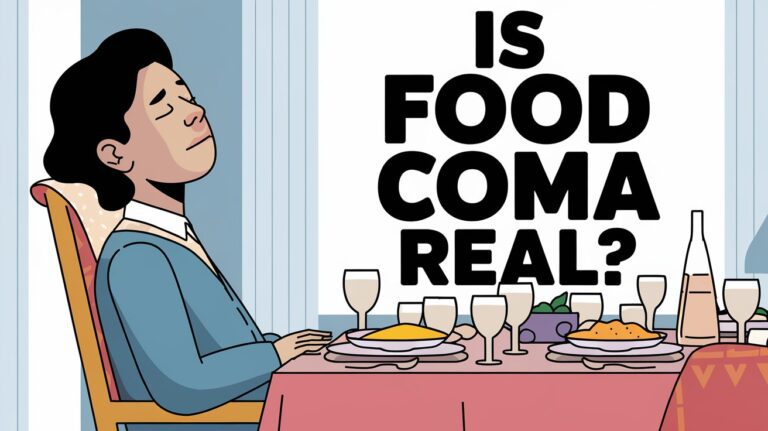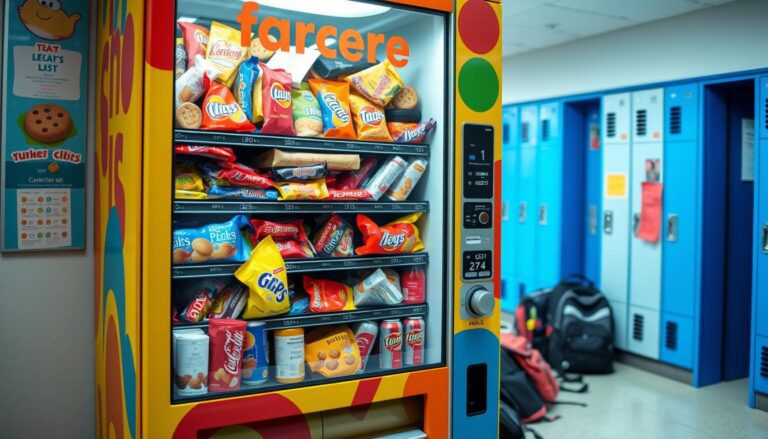Does Banning Junk Food Limit Students Choices? What You Need To Know
Is banning junk food in schools a good idea? It’s a topic of much debate. With nearly one-third of kids in the U.S. overweight or obese, it’s crucial to look at the effects of these bans. Schools are where kids make many of their food choices, so it’s important to understand how rules affect them.
This article will explore the complex issue of junk food in schools. We’ll examine studies and hear from experts to get a clear picture. We’ll see how these bans impact students’ eating habits, health, and even their schoolwork.
Some people think banning junk food helps kids eat healthier and do better in school. Others believe it takes away their freedom and doesn’t really change what they eat outside of school. The situation is made more complicated by the different economic backgrounds of schools. We’ll look at both sides of the argument and see how these policies can change what kids eat.
Key Takeaways
- Nearly one-third of U.S. children and adolescents are considered overweight or obese.
- The introduction of food bans in schools may improve nutrition and potentially academic performance.
- The impact of junk food bans can vary based on socioeconomic factors within school populations.
- Some argue that banning junk food limits student choices and autonomy.
- Successful interventions require a combination of strategies rather than a sole focus on food restrictions.
- Legislation aimed at improving school nutrition has shown mixed results across different income levels.
Understanding the Concept of Junk Food
Junk food is more than just a term; it’s a serious issue for student health. It’s high in calories but low in nutrients. Foods like chips, sugary drinks, and candy are often sold in schools. These choices affect what students eat every day.
What is Junk Food?
Junk food lacks nutritional value but is full of calories. It doesn’t give students the vitamins and minerals they need. Instead, it can cause health problems. Brands target kids and teens with these snacks, worrying about their long-term effects.
Common Examples of Junk Food
- Fast food options such as burgers and fries
- Soda and sweetened beverages
- Candy bars and gummies
- Processed baked goods like doughnuts and cakes
- Chips and other salty snacks
Nutritional Impact on Students
The effects of junk food on students are concerning. One in three kids and teens in the U.S. is overweight or obese. This number has nearly tripled since 1963. Childhood obesity is now the top health worry for parents, surpassing drug abuse and smoking.
These unhealthy snacks harm students’ health and school performance. Students who eat a lot of junk food often do worse in school. This highlights the need for healthier food options in schools.
The Debate Around Junk Food Bans
The debate on junk food bans in schools is complex. Some say it’s good for students’ health, while others think it’s a personal choice issue. This section looks at both sides of the argument.
Arguments For Banning Junk Food
Those who support junk food bans say they help students make better food choices. Studies show that over 50% of students eat junk food every day, which can lead to obesity. By banning junk food, schools can promote healthier eating habits.
In New York City, banning sugary drinks cut student consumption by 25%. California also saw a drop in obesity rates after banning unhealthy foods. Supporters believe schools should focus on students’ health, as better nutrition can improve grades.
Arguments Against Banning Junk Food
Those against junk food bans worry they limit students’ freedom to choose what they eat. They suggest teaching students about nutrition instead of banning foods. Schools often struggle with budgets, making it hard to offer healthy, tasty options.
The Obesity Society points out that many factors influence students’ eating habits. Bans might even make students eat worse outside of school. It’s a complex issue that needs careful thought.
Impacts on Student Choices
Removing junk food from schools changes how students pick their food. They start choosing healthier options, which helps them develop good eating habits. It shows how crucial it is to have a school menu that’s both healthy and varied.
Changes in Food Selection
Without junk food, students prefer fruits, veggies, and whole grains. Studies show this helps them eat better and stay healthy. Schools that offer healthier foods see students enjoying fresh produce more.
Alternatives Available in Schools
Healthier choices are now available in schools to replace junk food. Schools offer:
- Fresh salads and vegetable mixes
- Whole grain bread and pasta options
- Low-fat dairy products
- Fruits as snacks and desserts
- Nutritious protein sources like beans, lentils, and lean meats
These options encourage healthy eating and promote wellness. Instead of junk food, students now have many nutritious choices. This change could improve their health and school performance.

Health Benefits of Reducing Junk Food
Limiting junk food in schools boosts students’ health. Schools can teach healthy eating habits. This leads to better nutrition and overall well-being for students.
Improved Nutrition and Academic Performance
Good nutrition helps students do better in school. Studies show that junk food bans help students eat better. This can make them more focused and do well in school.
For example, in Canada, banning junk food for a few years can lower BMI. Students who go to schools with these bans for five years or more might lose two pounds. This small weight loss can help them stay focused and do well in school.
Long-term Health Outcomes for Students
Junk food bans also help students in the long run. They help prevent obesity and diseases like type 2 diabetes and heart disease. Schools in Mexico have banned junk food to help kids eat less and stay healthy.
Following these bans can lead to big weight losses. Schools help students not only do well in school but also stay healthy for life.
Psychological Effects of Food Choices
The link between food and psychology is key in schools. Students face many pressures, with friends’ opinions being a big one. This helps us see how school food rules affect students’ feelings and mental health.
Influence of Peer Pressure on Eating Habits
Friends can really sway what students eat. At lunch and snacks, they might pick unhealthy foods to fit in. Teenagers, in particular, want to please their friends, leading to more fast food and less healthy eating.
Emotional Responses to Food Restrictions
Students might feel upset by school food rules. Feeling left out can make them dislike healthy foods. This can lead to them eating badly as a way to show they’re in charge.
Bad food choices can harm students long after lunch. Eating too much fast food can hurt their grades and mental health. Schools need to help create a better food environment. They should encourage healthy eating but also respect what each student likes.
| Food Choice Factors | Potential Psychological Effects |
|---|---|
| Peer Pressure | Increased fast-food consumption, disregard for healthy options |
| Food Restrictions | Rebellion through unhealthy eating, feelings of deprivation |
| Fast-Food Consumption | Poor academic performance, psychiatric distress |
| Healthy Eating Promotion | Enhanced self-esteem, positive relationship with food |
Role of Schools in Promoting Healthy Eating
Schools play a big role in teaching kids about healthy eating. They can start by offering fun educational programs and workshops. These help kids learn about making good food choices.
Educational Programs and Workshops
Teaching kids about nutrition is key. Workshops with cooking demos or nutrition lessons can make a big difference. They help kids develop healthy eating habits that last a lifetime.
Collaborations with Parents and Community
Working with parents and local groups can make a bigger impact. Events like cooking classes or farmers’ markets get families involved. This helps kids see healthy eating as a part of their lifestyle, not just a rule.
Schools that team up with the community can really help kids make better food choices.

| Program Type | Description | Impact on Student Choices |
|---|---|---|
| Nutrition Workshops | Hands-on sessions to teach healthy cooking | Increased acceptance of healthy foods |
| Farmers’ Market Events | Community engagement to access fresh produce | Encourages consumption of fruits and vegetables |
| Parent Collaboration | Joint events with parents to support nutrition | Creates a consistent message on healthy eating |
| Health Education Curriculum | In-school programs teaching nutrition facts | Improves overall dietary decisions |
By focusing on education and community involvement, schools can really shape healthy eating habits. This shows how important it is to promote good food choices for kids.
Case Studies: Schools with Junk Food Bans
Many schools in the U.S. have banned junk food. They do this to offer better food choices and fight childhood obesity. Studies show both good results and challenges from these bans.
Success Stories: Positive Outcomes
Studies show schools banning junk food have seen big health wins. A study found an 18% drop in overweight or obese students after junk food bans. This shows small changes can make a big difference in health.
Also, more students want to eat healthy foods. This shows they are starting to make better choices.
Challenges Faced in Implementing Bans
But, there are also challenges. Students might resist changes to their favorite foods. Even with efforts to promote healthy eating, many students still get junk food.
There’s also worry about losing money from vending machines. This leads to debates among school boards and parents. It’s important to watch how these bans work to make sure they succeed.
As schools deal with these issues, sharing success stories is key. It helps in making better school food rules.
Finding a Balance
Finding a balance is key when promoting healthy choices and giving students freedom. Schools can use strategies to encourage healthy eating without being too strict. By offering a variety of healthy foods, schools help students make better choices.
Strategies for Healthy Eating Without Restrictions
One good way is to make vending machines better. Add healthy snacks like fruit cups, yogurt, and whole-grain bars. This lets students choose what they eat, teaching them about nutrition and decision-making.
Encouraging Responsible Choices Among Students
Schools can also start programs that reward good choices. This could be for choosing healthy meals or joining in fun challenges. These efforts help build a culture that values nutrition and empowers students to make smart choices.
| Strategy | Description | Expected Outcome |
|---|---|---|
| Healthy Vending Machines | Offer a variety of nutritious snacks in vending machines. | Empower students to make healthier food choices. |
| Reward Programs | Implement recognition systems for choosing healthy foods. | Encourage continued responsible eating habits. |
| Nutrition Education | Conduct workshops and classes on healthy eating. | Increase awareness and knowledge about nutrition. |
| Engaging Challenges | Organize activities that motivate students to try healthy foods. | Foster excitement about healthy eating. |
Conclusion: Rethinking Food Policies in Schools
Schools face many challenges when dealing with dietary restrictions. The debate over banning junk food shows the complexity of promoting healthy choices. It’s important to remember that just removing unhealthy food doesn’t always lead to better eating habits.
Students might even feel resentful instead of making positive changes. Programs like the Edible Schoolyard show that teaching about food can help students understand the environment better. This can also improve their academic success.
Summary of Key Points
Simply banning unhealthy food doesn’t solve the problem of student health. Childhood obesity and early diabetes are big concerns. Schools need a more detailed approach to food policies.
They should evaluate programs, use new ways to teach nutrition, and involve the community. Chile’s success with marketing regulations shows that a wide approach can work. This suggests that schools need to look at the bigger picture for effective policies.
Future Considerations for School Districts
School districts should focus on creating food policies that support healthy eating. They need to consider all the factors that influence student choices. Researching food marketing and adding nutrition to the curriculum is key.
This can lead to lasting health benefits. By creating a supportive environment and engaging students, schools can help them make better food choices. This tackles the problem of unhealthy food options head-on.







